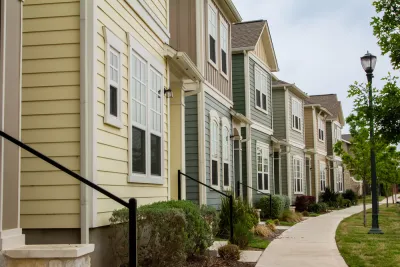The "missing middle" of housing is a concept familiar to many planners, but it's still probably unknown to most of the public. A story for Austin's NPR station could be an indication that the missing middle is entering the public consciousness.

Audrey McGlinchy kicks off the first of a two-part series about missing-middle housing and CodeNEXT—the city of Austin's ongoing zoning code update—with the story of Annette Naish, who lives in a two-bedroom, one-and-a-half-bath bought for $57,000 in the late 1990s. "Naish lives in a fourplex, or one unit in a group of four attached homes. It’s a rare breed in Austin. Some say it’s missing," writes McGlinchy.
"The term 'missing-middle' housing was coined by the head of Opticos Design Inc., the consultant helping the City of Austin with CodeNEXT, the rewrite of the land development code," adds McGlinchy, to begin the explainer of a concept usually in the purview of APA conferences and Planetizen posts.
The public is more and more aware of the issues of housing affordability around the country, so it makes sense that more and more of the public should be aware of the missing middle concept.
Researchers at the University of Southern California Price School of Public Policy recently found that the construction of missing-middle housing peaked in the 1970s and '80s. (Naish’s fourplex, for example, was built in 1972.) But since 1990, the construction of missing-middle housing has made up only about 15 percent of new housing stock in the U.S.
The article includes more on the case for missing middle housing, especially the benefits of affordability relative to the other types of housing available in Austin, and cities around the country. It should also not come as a surprise that missing middle housing is one of the goals of the code regulations proposed by the draft versions of CodeNEXT, released in February.
FULL STORY: What Is 'Missing-Middle' Housing?

Analysis: Cybertruck Fatality Rate Far Exceeds That of Ford Pinto
The Tesla Cybertruck was recalled seven times last year.

National Parks Layoffs Will Cause Communities to Lose Billions
Thousands of essential park workers were laid off this week, just before the busy spring break season.

Retro-silient?: America’s First “Eco-burb,” The Woodlands Turns 50
A master-planned community north of Houston offers lessons on green infrastructure and resilient design, but falls short of its founder’s lofty affordability and walkability goals.

Test News Post 1
This is a summary

Analysis: Cybertruck Fatality Rate Far Exceeds That of Ford Pinto
The Tesla Cybertruck was recalled seven times last year.

Test News Headline 46
Test for the image on the front page.
Urban Design for Planners 1: Software Tools
This six-course series explores essential urban design concepts using open source software and equips planners with the tools they need to participate fully in the urban design process.
Planning for Universal Design
Learn the tools for implementing Universal Design in planning regulations.
EMC Planning Group, Inc.
Planetizen
Planetizen
Mpact (formerly Rail~Volution)
Great Falls Development Authority, Inc.
HUDs Office of Policy Development and Research
NYU Wagner Graduate School of Public Service




























